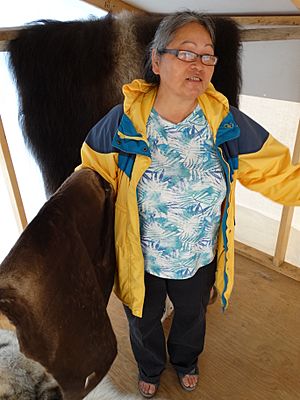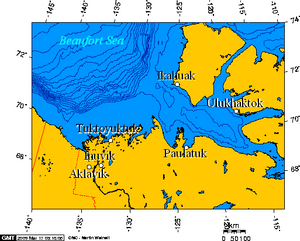Inuvialuit facts for kids

The flag of the Inuvialuit people.
|
|

Eileen Jacobson, Inuvialuit guide
|
|
| Regions with significant populations | |
|---|---|
| Canada Northwest Territories |
|
| Languages | |
| Inuvialuktun, English | |
| Religion | |
| Inuit religion, Christianity | |
| Related ethnic groups | |
| Other Inuit and Eskimo |
The Inuvialuit (say: In-oo-vee-AH-loo-eet) are a group of Inuit people who live in the western part of the Canadian Arctic. Their name means "the real people." Like other Inuit, they are descendants of the Thule who traveled east from Alaska a long time ago.
Their homeland, called the Inuvialuit Settlement Region, stretches along the Arctic Ocean coast. It includes parts of the Beaufort Sea and Amundsen Gulf, some western Canadian Arctic Islands, and inland areas like Aklavik and parts of Yukon. This special land was officially recognized in 1984 by an agreement called the Inuvialuit Final Agreement.
Contents
History of the Inuvialuit People
The Inuvialuit Settlement Region was once mostly home to the Siglit Inuit. However, their population greatly decreased in the late 1800s. This happened because new diseases were brought into the area.
In the 1910s and 1920s, Nunatamiut, who were Alaskan Inuit, moved into the traditional Siglit areas. They were interested in the renewed demand for animal furs from companies like the Hudson's Bay Company. These Nunatamiut who settled in the Siglit area became known as Uummarmiut.
At first, the Siglit and Uummarmiut did not get along well. But over time, they married each other, and their differences faded. With better healthcare and intermarriage, the Inuvialuit population now numbers about 3,100 people.
Reindeer Herding Project
In the 1930s, the Inuvialuit were part of a Canadian government plan. The goal was to make reindeer herding the main way people earned money in the Western Arctic. Thousands of domesticated reindeer were moved from Alaska to a new community called Reindeer Station.
Indigenous Sámi people from Norway were brought in to teach Inuvialuit men how to care for their own reindeer herds. However, this program was not very successful. It required a lonely lifestyle and was not as profitable as traditional hunting and trapping.
Different Names for Inuvialuit
A report from 2006 about Inuvialuit traditional knowledge shared more about how people named themselves. Inuvialuit living in the west are called Ualinirmiut (Ualiniq) by those in the east. Inuvialuit in the east are known as Kivaninmiut (Kivaliniq) by people from the west.
The Inuit living in Ulukhaktok are not Siglit or Uummarmiut. They are Copper Inuit and call themselves Ulukhaktokmuit. This name comes from Ulukhaktok, which is the traditional name for what was once called Holman.
Inuvialuktun Language
The traditional language of the Inuvialuit is called Inuvialuktun. It is made up of three or four different ways of speaking, called dialects.
- Uummarmiutun is spoken by the Uummarmiut in Aklavik and Inuvik. It is a dialect of Inupiatun, but it is usually grouped with Inuvialuktun.
- Siglitun is spoken by the Siglit people in Sachs Harbour, Paulatuk, Tuktoyaktuk, and Inuvik.
- Kangiryuarmiutun is used by the Kangiryuarmiut in Ulukhaktok. This dialect is very similar to Inuinnaqtun. Inuinnaqtun is also spoken in the Nunavut communities of Kugluktuk, Bathurst Inlet, and Cambridge Bay.
- Natsilingmiutut is used by the Netsilingmiut in Gjoa Haven, Taloyoak, Kugaaruk, and Repulse Bay in Nunavut.
Uummarmiutun, Siglitun, and Inuinnaqtun (Kangiryuarmiutun) are all written using the Latin script. Natsilingmiutut is written using Inuktitut syllabics, which are special symbols for sounds.
Inuvialuit Culture and Traditions
Throughout the year, Inuvialuit hunt caribou from the Cape Bathurst and Bluenose herds. They also share the Porcupine herd with the Gwich’in people. Sometimes there has been disagreement between the Inuvialuit and the Gwich’in about caribou hunting.
Other activities happen during specific seasons:
- Spring: People go fishing, hunt geese, and hunt grizzly bears.
- Summer: This is the time for whaling, fishing, and gathering berries, roots, and medicinal plants.
- Autumn: People fish, hunt seals, hunt geese, and gather plants.
- Winter: Activities include fishing, sealing, and hunting polar bears.
Traditional Games
The Inuvialuit have many traditional games they play:
- akimuq: This is a high kick game.
- ayahaaq: This is a string game, similar to cat's cradle.
- iglukisaaq: This involves juggling rocks.
- mak': This game is played by trying to make another person laugh.
- napataak: This is a darts game played with a wooden handle and a sharp nail.
Inuvialuit Communities
| Inuvialuit communities | ||||||
|---|---|---|---|---|---|---|
| Community | English translation | 2006 population | Inuvialuit | First Nations | Métis | non-Aboriginal |
| Aklavik | "barren-ground grizzly place" | 594 | 350 | 185 | 10 | 40 |
| Inuvik | "place of man" | 3,484 | 1,335 | 630 | 160 | 1,260 |
| Paulatuk | "place of coal" | 294 | 260 | 0 | 0 | 30 |
| Sachs Harbour | traditionally called Ikahuak, meaning "where you go across to" | 122 | 105 | n/a | n/a | 15 |
| Tuktoyaktuk | "resembling a caribou", formerly known as Port Brabant | 870 | 705 | 20 | 10 | 145 |
| Ulukhaktok | "a large bluff where we used to collect raw material to make ulus", formerly known as Holman | 398 | 360 | 10 | 0 | 30 |
The land area covered by the Inuvialuit Settlement Region is about 521,707.68 square kilometers. Some communities, like Aklavik (Aklavik Indian Band, Ehdiitat Gwich’in Council) and Inuvik (Nihtat Gwich’in Council), are shared with the Gwich’in people. The Gwich’in are represented by the Gwich’in Tribal Council.
See also
 In Spanish: Inuvialuit para niños
In Spanish: Inuvialuit para niños




